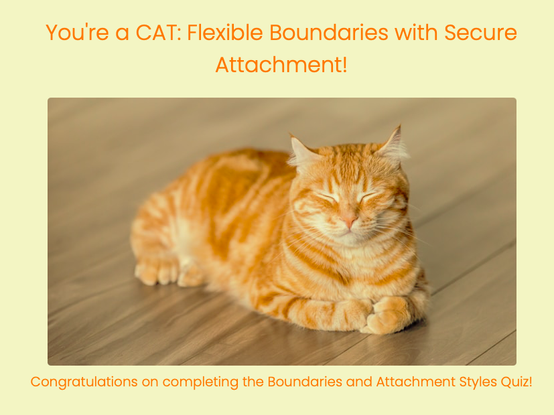Secure Attachment – from Childhood to Adult Relationships
i took the boundaries or avoidance quiz by AZ Therapists Tehrina and Joel and my result is Cat: Flexible boundaries with secure attachment.
You can take the free quiz here (they send the results via email) but you also get your instant answer on the page when you finish the 15 questions :)
Not sponsored, just a fan of their YouTube channel. QUIZ here, LMK what you got?
The Dismissive Avoidant Danger Zone (6of6)
They will deflect your concerns, project their insecurities onto you, and stonewall when things get tough.
Key Takeaway: Dismissive Avoidants are often running from something profound: the vulnerability inherent in true connection. Your most important job is to recognize these patterns early, listen to your inner voice screaming "this isn't right," and ultimately, choose yourself and your own emotional well-being.
Have you encountered these patterns in your relationships? What were the red flags you wish you'd recognized sooner?
These posts are a massive simplification of course, there is no summarizing this in 4 slides, it's just intended to point out a possible path.
There are free support groups online too, so much more accessible these days. David Kessler has got lots of resources @iamdavidkessler both paid and free for bereaved people.
I just want to say that continuing bonds is a secular idea, it can be spiritual or aspiritual, you can, for example, believe in the soul of a person staying with you, or you can hold onto the impression they have made in your heart and the impact they have had on you and hold that with you; you can find the way of keeping them with you that is true and real for you.
In Ireland:
you can free call the Samaritans at any time on 116 123 at any time if you need someone to listen. You can also email them if you prefer, jo@samaritans.ie
Irish Hospice foundation have a helpline for bereavement support which runs from 10am to 1pm on weekdays, it's 1800 80 70 77
Academic stuff:
https://journals.sagepub.com/doi/10.1177/0030222815576124 < insecure attachment styles and complicated grief
A study finding 93% of ADHDers had insecure attachment:
https://findresearcher.sdu.dk:8443/ws/portalfiles/portal/134088245/Association_Between_Insecure_Attachment_and_ADHD.pdf (I've seen other numbers other times, but the percentage is always extremely high).
#grief #bereavement #complicatedgrief #adhdgrief #griefandloss #bereavementcounselling #adhdandgrief #griefsupport #adhdireland #attachment #attachmentstyles #insecureattachment #avoidantattachment #fearfulattachment #fearfullyattached #preoccupiedattachment #ambivalentattachment #continuingbonds #davidkessler #psychology #psychiatry #psychologystudents #psychotherapy #counselling #persistentcomplexbereavement
The Power of Connection: Building Resilience in Mental Health
#MentalHealthMatters #Resilience #MentalHealthLiteracy #AttachmentStyles #CommunitySupport #PsychosocialRehabilitation #Stigma #SelfEfficacy #WellBeing #MentalHealthAwareness #EmbraceTheJourney #ConnectionIsKey
Bridging Generations: The Impact of Intergenerational Attachment Styles on Couples Therapy
#CouplesTherapy #AttachmentStyles #IntergenerationalWisdom #ConflictResolution #HealthyRelationships #EmotionalPatterns #FamilyDynamics #TherapyInsights #RelationshipAdvice #CommunicationSkills #EmotionalIntelligence #LoveAndConflict #UnderstandingAttachment
Unraveling Attachment Styles: The GPS of Human Connections
#AttachmentStyles #HumanConnections #Relationships #PsychosocialVulnerability #Neuroticism #Psychoanalysis #DyadicAnalysis #InterdependenceModel #EmotionalIntelligence #Vulnerability #LoveAndFriendship #MentalHealthAwareness #SelfDiscovery #PersonalGrowth
#AttachmentStyles seem to be a hot topic in psychology at the moment.
Wondering if #Autistic and #ADHD people tend to land in the same group. #AuDHD


